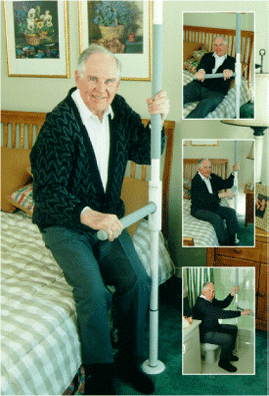When it comes to grab bars, do you know the proper placement and usage? This extends to the use of any aids to daily living that are intended to increase accessibility and autonomy around the home. A lack of information can lead to problems when adapting to these life-changing implements.
When you think of mobility devices, your mind likely goes to scooters and lifts but there are many assistive aids you may not be considering. Consider, for instance, grab bars and other aids to daily living that can reduce the risk of fall and prevent injury around the home. The key is to opt for medical aids and equipment sold by merchants who offer service and support to ensure satisfaction and an increase in accessibility once installed.
When it comes to grab bars, do you know the proper placement and usage?
Don’t underestimate the installation of a grab bar in the home, and never settle for something secured with suction cups. This is an accident waiting to happen! When you need aids to daily living, treat it just as you would when looking for a wheelchair or scooter. Patronize professional mobility retailers that put your needs first and that offer support to their customers.
Where do you put the grab bar?
Probably the most common placement of a grab bar is in the bathroom, near or next to the commode. This often provides access and support at the sink, too, since the plumbing is often entwined. Another option is to have a grab bar near the tub, but there are other bathing and showering aids that could prove more pragmatic for your distinct bathroom space.
When is the right time for a reaching tool?
Anyone can benefit from a reaching tool; these ‘grabbers’ can be effective ways to avoid the risks that lurk in kitchens, bathrooms, pantries, and closets. As individuals age, balance can be compromised which can increase the risk of a fall. Make any room of the home a safer place to be for anyone with physical limitations by investing in reaching tools that can be used anywhere, at any time.
Do you – or someone you love – need bed rails?
Bedrails do far more than give a nudge upon waking; these discreet fixtures can provide a buffer to help restless sleepers from falling out of bed. They can also help reduce the stress and strain on joints when retiring at night, by offering a support that makes it easier to recline. Many styles can be locked in place and lowered as needed, which makes changing bedding and linens simpler.
What does a super-pole do?
For innovative assistance that is helpful when standing, shifting, or transferring. The distinction between this grab bar and other devices is the floor-to-ceiling bar, offering stability and security that canes or walkers may not provide. Ask your mobility expert about this award-winning device to increase autonomy and mobility in your home space. These adjustable aids offer both seniors and caregivers the added assistance that may prevent injuries during activities of daily living.
Does a seat make sense?
It is estimated that around 95% of hip fractures among the elderly are the result of a fall; it is further reported that around 13% of senior falls occur in the bathroom, including in the shower. Does a seat make sense in your bathroom shower? Even if the consumer prefers to stand independently while showering, a seat can be an excellent way for the senior to navigate getting in and out of the tub. While the sides may prove challenging, even a fall-risk for seniors with poor balance, sitting on the seat positioned over the tub side-wall can allow them to swing their legs in rather than lift and lower. Additionally, this may be a safer approach on wet and slippery surfaces – like the tub, shower, and bathroom floors.
Would a tray-table help?
They have been used in hospitals and healthcare settings for generations, but what is the deal with tray-tables? The sleek style and stability of tray-tables can transform a favorite chair into a convenient and useful space. The casters allow for locking and keeping the table in place, and the adjustable height will fit any chair, bed, or spot that you choose to place it in. Make sure that you buy medical-grade tray-tables to ensure you are getting the same quality seen in healthcare institutions, hospitals, and rehab settings widely.
Don’t write off mobility aids as being restricted to scooters and wheelchairs; sometimes the smallest bit of assistance can make the biggest difference in everyday life. Consider how a grab bar, or other aids to daily living, could increase safety, enhance access, and lessen worry when it comes to protecting someone that you love. Talk to the experts in mobility aids, devices, and equipment about a needs assessment and more information pertaining to simple solutions for daily challenges.
President, Husband, Father, Grandfather Graduate of UC Davis- Bio Sci Major- Go Aggies! Jeff has extensive experience in all of Pacific Mobility’s products and services, and specializes in accessibility products as well as stairlifts, ceiling lifts and custom wheel chairs. His hobbies include spending time with family, gardening, mountain biking, exercising and off road motorcycle riding.
24 years as Owner/President of Pacific Mobility Center – selling, installing, and servicing stairlifts, porch lifts, ceiling lifts, pool lifts, handicap ramping, specialty wheelchairs, scooters, power wheel chairs, and other power mobility devices
Certified Environmental Access Consultant since 2008
Licensed General Contractor since 1998
Certified Aging in Place Specialist since 2016
Board Member for Home Access Professionals
Member of Association of Members of the Accessibility Equipment Industry (AEMA)




